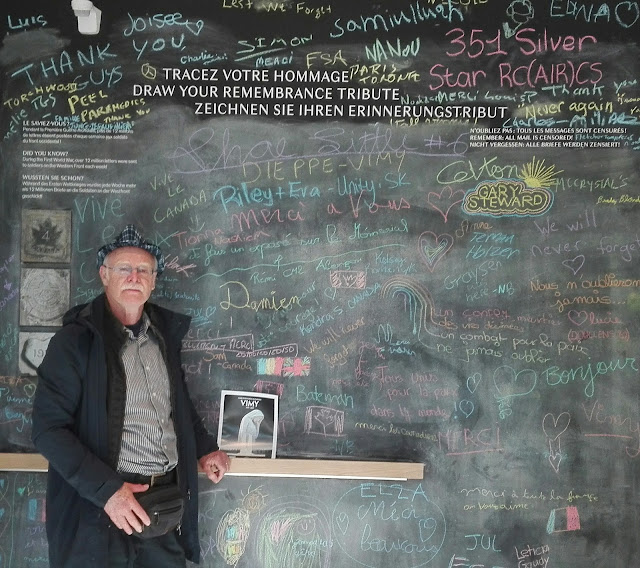 |
| trail to Vimy Ridge |
After breakfast we set out for Vimy Ridge, the temperature cold under a cloudless sky. Frost still lay in the shade of the trees lining the trail as we passed by the small Canadian cemetery and continued on a mile or so to the great Canadian Memorial. Vimy Ridge is a long high hill that dominates the surrounding landscape. Germany captured it early in the war and transformed it into a strong defensive position, with a complex system of tunnels and trenches manned by highly trained soldiers with machine guns and artillery pieces. The Canadians moved to the front lines across from Vimy Ridge in late autumn of 1916, spending the entire winter strengthening the lines, preparing for the assault on Vimy and gathering intelligence on the German defences. After massive artillery barrages to soften up the enemy the battle began at 9am Easter Monday, April 9, 1917, the Canadians advancing into the face of deadly machine gun fire. Most of the heavily defended ridge was captured by noon, Hill 145 the next day and two days later the next high ground. We suffered more than 10,600 casualties (nearly 3600 fatal) and in the end helped create a new and stronger sense of national identity which has survived to this day. We stopped first at the Visitor Centre to get acquainted with the site with the displayed maps, presentation boards, photos and military exhibits, then joined a small group on a tour of the tunnels carved 7 metres below in the chalky stone. We then headed through the new woods, planted after the war, amongst the crated landscape to the memorial itself. It was as I remembered it from 1963 or 64 when we were living in Metz, it's white twin pylons outlined against the blue sky. As we got closer we could see signs of last week's 100th anniversary ceremonies that had been attended by Canadian Prime Minister Trudeau.
 |
| Memorial cross erected on Vimy Ridge by the 15th Battalion immediately following the battle |
 |
| Marie signing her name in the 'Commitment to Remember' display |
 |
| Cratered by shell fire, the land about Vimy Ridge |
 |
| underground |
A bitterly cold wind blew across the rolling hills and we sought shelter in the lee of one of the giant pylons. The limestone that was carved on site was brought from an abandoned Roman quarry on the Adriatic sea, the monument' ceremonial opening in 1936 by Edward VII and the French President. A cloaked figure made from a single 30-tonne block of stone stands at the front of the monument overlooking the Douai Plain, representing Canada - a young nation mourning her dead. Carved on the walls of the monument are the names of some 11,285 Canadians who died in France and whose final resting place was then unknown. The twin white pylons, one bearing the maple leaves of Canada, the other the fleur-de-lys of France, symbolize the sacrifices of both countries.
 |
| Marie and I,100 years almost to the day of the Battle of Vimy Ridge |
We had lunch after leaving the Memorial in a cafe recommended by our host, La Table de Pascal, known for it's preparation of local cuisine. Afterwards we walked a kilometre or so to the Cabaret Rouge Cemetery, a large but beautifully kept British and Canadian cemetery on the outskirts of Souchez named after a restaurant, that stood on the site prior to the war. It was well marked on the main road but we had taken a detour through a farmer's back lane and met up with his cows. Cabaret Rouge was unbelievably moving and it's peaceful setting was a tribute to the men buried there, those named and those known only to God. After one last look at the thousands of crosses we retraced our steps back into town and up the hill to the Centre d'Histoire Guerre et Paix to check out the extensive data base of over 580,000 soldiers killed during the war that are commemorated on the Ring of Remembrance we had visited yesterday. Tomorrow we leave for Caen and the site of the D Day invasion to remember and honour those who sacrificed their lives in the next war, a mere 21 years later. gws
 |
| Cabaret Rouge Cemetery, 7600 Canadian and British soldiers |
 |
| The countless white crosses stand mute in the sand to man's blind indifference to his fellow man, to a whole generation that were butchered and damned |
"Do you mind if I sit here down by your grave and rest for a while in the warm spring sun
I've been walking all day and I'm nearly done.
I see by your graveside you were only 19 when you joined the great fallen in 1915.
I hope you died well and I hope you died clean...
Or was it slow and ...obscene."
. v





















